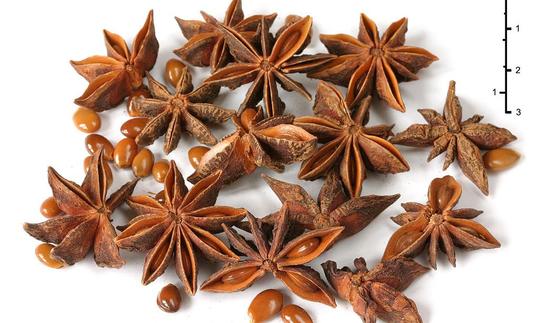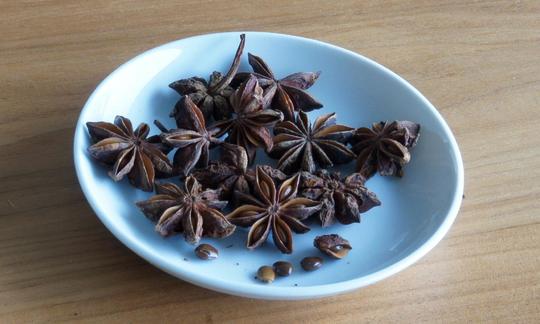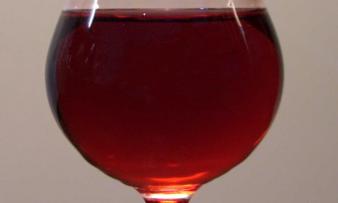Table of contents
Star anise ( Illicium verum) has long been established as a popular winter spice thanks to its sweet, licorice-like taste. In addition to its classic use in gingerbread and Christmas tea , Chinese star anise is also used for medicinal purposes outside of cooking due to its ingredients.
Use in the kitchen:
Real or Chinese star anise has a sweet and licorice-like aroma with peppery and sour notes. Are star anise and anise the same? No, but the aromas of (small) anise ( Pimpinella anisum) , fennel ( Foeniculum vulgare) and the nowadays rarely used sweet cicely ( Myrrhis odorata) are perceived as very similar. 1
Together with the spices Sichuan pepper, fennel, cassia cinnamon and cloves, real star anise is known in Chinese cuisine as five-spice powder. It can also be a component of Indian curry. Asian meat dishes such as Peking duck are flavoured with star anise. Star anise is used whole, with the shell (because the shell is more aromatic than the seeds) or ground. 1
To give muesli a special flavour, for example, you can grind Chinese star anise with an electric coffee grinder, including seeds because of the small amount, which takes about 12 seconds. Sometimes there will be larger pieces left over, which you can pick out, but you don't have to.
Ground or powdered star anise is often added to gingerbread and bread spices. As a whole, star anise gives tea, mulled wine, punch, and even rice dishes a pleasant taste and a decorative effect.
Recipe for homemade star anise oil:
Preparation : Homemade star anise oil is perfect for refining winter desserts and baked goods. To do this, take a screw-top jar with dried star anise fruits and fill it to the brim with vegetable oil ( linseed or rapeseed oil has a healthier fatty acid composition thansunflower oil). If you leave it for at least 2 weeks and turn it every now and then, the oil will develop a delicious star anise flavour. Please do not confuse it with real star anise oil (Anisi stellati aetheroleum).
Recipe for tea with star anise:
Preparation : Star anise also tastes good as a tea. The ripe, dried fruit can be poured over pure or combined with other tea blends. For about 250 ml of boiled water, you need 1-2 chopped star anise fruits. This combination is left to steep covered for 10-15 minutes and then drunk warm. The sweet, warming taste is particularly popular in the cold winter months and also helps with digestive problems. 2
Vegan recipes with real star anise can be found under the note: " Recipes that have the most of this ingredient ".
| Not only vegans or vegetarians should read this: Vegans often eat unhealthily. Avoidable nutritional errors. |
Shopping - where to buy?
You can buy real, whole star anise during the Christmas season from almost all major retailers ( Coop, Migros, Denner, Volg, Spar, Aldi, Lidl, Rewe, Edeka, Hofer etc.) or in supermarkets. Certain supermarkets also stock star anise all year round and in ground form. Only a few supermarkets offer organic star anise. But in organic shops, health food stores or online shops you should be able to find whole or ground star anise and organically produced all year round. Look for organic.
Storage:
For long-lasting freshness, star anise should be stored in airtight containers. Stored in a dark place, it will last up to three years. 1
Ingredients - nutritional value - calories:
Like many spices, real star anise contains a high proportion of valuable essential minerals such as iron, manganese, copper, calcium, potassium, phosphorus, zinc and magnesium. 3 Of course, essential amino acids and vitamins as well as fatty acids are also present. You can find more information about the nutrients in the table at the bottom of the text.
Particularly important are essential oils such as anethole (80-90%) and methyl chavicol (up to 6%). They are found in the fruit wall and make up only 5 to 8% of the fruit. They also contain (a small amount of) phellandrene, linalool, safrole and terpineol. The trace amounts of 1,4-cineole in star anise are absent in anise.
In addition, star anise contains foeniculin, anisaldehyde, monoterpenes such as limonene, pinene and linalool as well as flavonoids and small amounts of veranisatins. 1
The complete ingredients of real star anise, the coverage of the daily requirement and comparison values with other ingredients can be found in our nutrient tables. In the article Nutrients explained you will get a detailed insight into the topic.
Health aspects - effects:
The use of star anise is similar to that of small anise. The expectorant, expectorant and slightly antispasmodic effect is used for catarrh of the respiratory tract or for digestive problems such as a feeling of fullness, flatulence and mild cramps. However, tea mixtures usually contain less star anise ( Illicium verum) and more anise ( Pimpinella anisum).
According to a study, star anise extract has anti-inflammatory and anti-allergic effects in atopic dermatitis (neurodermatitis). Star anise is said to suppress the formation of inflammatory mediators in the metabolism. 4
The essential oil of the star anise fruit also has antibacterial properties. The anethole it contains is mainly responsible for this. Isolated anethole is effective against bacteria, yeasts and fungal strains. 5 The shikimic acid it contains is also used as an injection in flu medication. 6
Dangers - intolerances - side effects:
Is star anise poisonous? The only answer is: everything is poisonous, it just depends on the amount. Pregnant women, babies and small children are advised not to take essential star anise oil internally. So this is only about the (concentrated) oil. In a study, isolated veranisatin (equivalent to about 10 kg of star anise) caused cramps in mice and was fatally toxic when taken orally (3 mg/kg). At lower doses, it led to hypothermia (hypothermia). 7 But this is about an isolated ingredient. When taking it, pay attention to the dosage stated.
In addition to safrole, real star anise also contains methyleugenol and estragole. These phenylpropanoids are also present in star anise and in many other tropical plants such as laurel plants, camphor trees, pepper and nutmeg. These substances are very toxic to the liver and kidneys and are suspected of being carcinogenic and mutagenic. In 2001, the Federal Institute for Consumer Health Protection and Veterinary Medicine (BGVV) specified maximum levels for the use of fragrance oils containing safrole, methyleugenol or estragole. 8 Methyleugenol and estragole were also found in tea infusions intended for babies, small children and nursing mothers. According to the BGVV, these substances are not permitted in food and their content must not be detectable. 9
Use as a medicinal plant:
The dried fruits of star anise are used as medicinal drugs in a similar way to the fruits of the small anise, because the content of the essential oil anethole is almost the same. 10 Thanks to its expectorant, expectorant and slightly antispasmodic effect, star anise is also used against coughs and digestive disorders, among other things. The European Pharmacopoeia ( Pharmacopoeia Europaea = Ph. Eur.) requires a minimum content of 86% trans-anethole in the essential star anise oil. 11,12
Medicinal anise oil for coughs is obtained from star anise and anise. 1 The expensive, real anise oil (Anisi aetheroleum) from the anise plant ( Pimpinella anisum) is often replaced by cheaper star anise oil (Anisi stellati aetheroleum).
The scent of star anise essential oil has a calming effect on us humans.
Folk medicine - natural medicine:
Star anise is used as a traditional herbal medicine because of its anti-inflammatory properties, especially in Asia. Treatments relate to skin problems, rheumatism, asthma, bronchitis and gastrointestinal complaints. There is also a tincture with star anise (not star anise).
In folk medicine, star anise is used to treat infant colic. The warm star anise oil is rubbed around the baby's navel using gentle, circular movements (clockwise because of the course of the intestines). 2
Occurrence - Origin:
The evergreen tree of the real star anise can be found in tropical areas from southeastern China to northern Vietnam. 1 The spice plant, which has been known for thousands of years, is now mainly exported to India and Europe.
Cultivation - Harvest:
The tree, which is green all year round, can reach a height of up to 20 m. The leaves are elongated-oval and taper to a point. The flowers are yellow-green, but sometimes appear in reddish pink to dark red. 15 The fruits are reddish-brown. A ripe pod fruit has a diameter of up to 3.5 cm, with 8 or 9 woody pod fruits, each with a kernel. Translated from Chinese, star anise means "eight-horned fennel". The shell is more aromatic than the kernels, which is why the whole fruit is used or ground. 1
The fruits are harvested shortly before they are ripe and dried in the sun or at low temperatures in drying plants. The star anise is then packaged in jars or bags and sold whole or ground. The essential star anise oil is obtained through steam distillation. 13
Danger of confusion:
The Japanese star anise or shikimi fruit ( Illicium anisatum, I. religiosum or I. japonicum) is very similar to the real star anise in smell and appearance. In Japan, the shikimi fruit is burned as incense, but it is not suitable as a spice. The neurotoxic sesquiterpene lactone anisatin it contains is very toxic to the liver, kidneys and bladder. Symptoms of poisoning include vomiting, visual disturbances, damage to the kidneys, urinary tract, digestive system and nervous system. 14
Due to the similarity, Japanese star anise is often mixed with Chinese (true) star anise.
General information:
The real star anise ( Illicium verum) belongs to the star anise family (Schisandraceae). In contrast to anise, which has a similar taste but is not as aromatic, the star anise does not belong to the umbelliferous family.
In addition to being used as a spice, star anise is also suitable for decorative purposes. The beautiful star-shaped pods combined with cinnamon sticks and dried orange slices make a fragrant, wintery potpourri. 13
Alternative names:
Real star anise or Chinese star anise are the two most common names in the German language. The name badian is outdated and comes from historical recipe books. In English it is called star anise, staranise, star anise seed, Chinese star anise or badiane. Spanish: anís estrellado, anís estrella, anís estrellado chino, badiana or badiana de China.
Literature - Sources:
Bibliography - 15 Sources (Link to the evidence)
| 1. | Wikipedia Echter Sternanis. |
| 2. | Blattgolddrbecker.blogspot.com Echter Sternanis - Illicium verum. |
| 3. | USDA United States Department of Agriculture. |
| 4. | Sung YY, Yang WK, Lee AY et al. Topical application of an ethanol extract prepared from Illicium verum suppresses atopic dermatitis in NC/Nga mice. J. Ethnopharmacol. 2012;144(1). |
| 5. | De M, De AK, Sen P et al. Antimicrobial properties of star anise (Illicium verum Hook f). Phytother Res. 2002;16(1). |
| 6. | Wang GW, Hu WT, Huang BK et al. Illicium verum: a review on its botany, traditional use, chemistry and pharmacology. J Ethnopharmacol. 2011:136(1). |
| 7. | Nakamura T, Okuyama E, Yamazaki M et al. Neurotropic components from star anise (Illicium verum Hook.fil.). Chem Pharm Bull (Tokyo). 1996;44(10). |
| 8. | BGVV Bundesinstitut für gesundheitlichen Verbraucherschutz und Veterinärmedizin. Gesundheitliche Bewertung von Duftölen, die Safrol, Methyleugenol oder Estragol enthalten. 2001. |
| 9. | BGVV Bundesinstitut für gesundheitlichen Verbraucherschutz und Veterinärmedizin. Gehalte an Methyleugenol oder Estragol in teeähnlichen Erzeugnissen. 2001. |
| 10. | Pahlow M. Das grosse Buch der Heilpflanzen. Nikol Verlag: Hamburg. 2013. |
| 11. | Pharmawiki.ch Sternanis. |
| 12. | Arnzeispflanzenlexikon.info Anis. |
| 13. | Vitaswiss.ch Sternanis nicht nur ein Weihnachtsgewürz. |
| 14. | Römpp Online Sternanis. Georg Thieme Verlag. |
| 15. | Royal Botanic Gardens, Kew. Illicium verum Hook.f. powo.science.kew.org. |












Comments